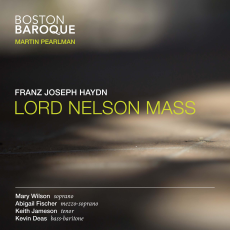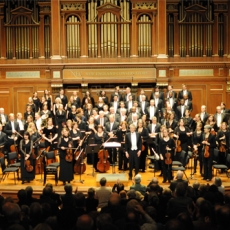Boston Baroque - Haydn: Lord Nelson Mass - Fanfare
I requested this release for three reasons: (I) I love Haydn's late masses and seldom miss an opportunity to acquire new recordings of them when they come out; (2) I'm a big fan of Martin Pearlman and his Boston Baroque; and (3) I wanted to compare Pearlman's version to two others, both also on period instruments: John Eliot Gardiner's with the English Baroque Soloists and the Monteverdi Choir on Philips, and Richard Hickox's with the Collegium 90 on Chandos. A surprise bonus on Pearlman's new Linn SACD is one of Haydn's late symphonies, an unusual coupling where most others pair the mass with another one or two of the composer's sacred choral works.
The background on Haydn's "Lord Nelson" Mass is well known. Composed in 1798, it's third in order of the six final masses Haydn wrote to celebrate the name day of the Princess Esterhazy. This particular mass came at a time of great stress and uncertainty for the Austrian empire, as Napoleon's army was poised to capture Vienna. In this troubled time, Haydn appropriately titled his score Missa in Angustiis (Mass in a Time of Anxiety). But no more than a week before the mass was to be performed, word reached Vienna that Admiral Horatio Nelson had sunk Napoleon's fleet. It seems not to have been Haydn's doing, but from that day forward, the Mass in a Time of Anxiety was rebranded the "Lord Nelson" Mass.
From the very first timpani stroke on the downbeat of bar one, I sensed this was going to be a really outstanding performance. But "outstanding" doesn't begin to capture how different and special it is. Starting in measure 38, one bar before the soprano soloist enters on the words "Christe eleison," fleeting 16th-note runs begin to be heard in the violins, increasing in frequency and length as the full chorus re-enters. At bar 54, one measure before the full chorus now resumes on the words "Kyrie eleison," the string figure has become omnipresent, mostly as cascades of descending scalelike figures alternating between firsts and seconds. I cite this passage because I've never heard it articulated the way it is here. Whether-intended or not, the effect of the light, off-the-string bowing Pearlman directs his strings to use has the effect of flurries of snowflakes dancing in the air as they drift delicately downward. It's quite magical.
The entire performance of the Mass is filled with felicities of phrasing, dynamics, and articulation like this too numerous to cite. But it's not just in the micro-detail Pearlman brings outenhanced, no doubt, by Linn's exceptionally pellucid SACD recording-that it differs from Gardinerand Hickox. Pearlman's reading differs fundamentally in its conception of the score. Where others take the minor key of the work, its original title, and its extra-musical association with the direness of the day in which it was written as cue to impose an extra sense of solemnity and end-of-times gravity on their performances, Pearlman views the "Lord Nelson" Mass as calling for a more intimate, almost chamber-like setting. And the conditions under which Haydn composed this particular Mass would seem to lend support to Pearlman's approach.
The fact that Haydn included timpani and three trumpets in the score is not its most salient feature. All six of the late masses include parts for timpani and two trumpets. Notable is what the original instrumentation for the "Lord Nelson" Mass doesn't include, parts for woodwinds. The financially strapped Prince Esterhazy found himself in a bind, and one solution was to downsize his orchestra, which he did by letting the woodwind players go. Haydn was now faced with having to score his mass for a smaller ensemble than he was accustomed to. Without woodwind instruments at his disposal, his original orchestration called for the aforementioned timpani and three trumpets, plus strings and organ. Thus, despite its minor key and anxiety over the troubled times, the "Lord Nelson" Mass really is conceived on a smaller scale than are its five siblings. So, Pearlman's view of the work is entirely justified. For later editions of the score, editors extrapolated parts for woodwinds from the organ part, but Haydn himself is not believed to have had a hand in it.
So here is where we come to what really distinguishes Pearlman's performance from the pack; he reverts to the original scoring without woodwinds. So too do Hickox and Gardiner, but Hickox adds a bassoon to the mix with his Collegium 90, and Gardiner's tempos feel driven, while his English Baroque strings sound edgy and overly aggressive. I didn't notice this so much until I compared Gardiner's recording to Pearlman's. None of the drama escapes Pearlman or his excellent lineup of vocal soloists, but his performance overall, in addition to the details of execution noted above, has a warmth, refinement, and soft-spoken nobility to it that strike me as being more reflective of the wisdom and life's lessons learned by the ageing Haydn. This is now my favorite version of the "Lord Nelson" Mass.
What does Haydn's Symphony No. 102 have in common, I wondered, with the "Nelson" Mass that prompted Pearlman to include it on the same disc? Was it written in the same year? No, it was composed four years earlier in 1794, 10th in order of the 12 so-called "London" Symphonies which Haydn produced for his visits to the British capital in 1791 (Nos. 93-98) and 1795 (Nos. 99-104). Is No. 102, like the Mass, scored for an orchestra minus woodwinds? Hardly; his London audiences would have demanded refunds. Did Haydn cleverly embed a quote from No. 102 in the later Mass? Not that anyone has so far discovered. So why is the Symphony No. 102 paired with the Mass?
Well, the best I can figure out from Pearlman's own album note is that he feels sorry for it. He believes it's the neglected sibling among the last five "London" symphonies because it's the only one that wasn't christened with a name. The other five were: No. 100, "Military," No 101, "Clock," No. 103, "Drum Roll," and No. 104 "London." Pearlman thus lends credence to something I've said on numerous past occasions, which is that works receive more attention simply by virtue of having a nickname.
But Pearlman pities the poor No. 102 for more than its going nameless. He believes it was robbed of its entitlement to be called the "Miracle" Symphony, like Esau robbed by Jacob of lsaac's blessing, through a sneaky switcheroo. Through some innocent, rather than guileful, substitution, it was the London premiere of the Symphony No. 96 that came to be celebrated as the miracle that no one was killed when the hall's chandelier fell from the ceiling. But it was actually the premiere of No. 102 which featured that dramatic finale.
I would add another reason for Pearlman's programming the Symphony No. 102 along with the "Nelson" Mass. His Boston Baroque is a fully outfitted orchestra, which includes a fine complement of woodwind players. So, it makes sense to choose a work to accompany the Mass that gives the woodwinds a chance to play and shine, and they do.
As I said at the outset, this is an unusual coupling, all the more so for the fact that most collectors who already have one or another version of the "Nelson" Mass are likely to have it as part of a larger survey of Haydn's Masses, and those who already have one or another version of the Symphony No. 102 are likely to have it as part of a complete "London Symphonies" cycle. Still, everything about this release, from the stunning performances to the phenomenal recording makes it impossible to resist.
If my tongue were long enough, I'd be licking my ears in delight. Now there's surely a visual image to recommend this disc.

